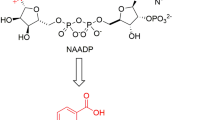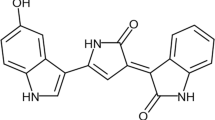Abstract
Suppressive potencies of tetrandrine, isotetrandrine, fangchinoline, berbamine, dauricine, cepharanthine, and armepavine on expression and activation of NF-κB in MOLT-4 cells, MOLT-4/DNR cells, peripheral blood mononuclear cells (PBMCs) of healthy subjects and PBMCs of dialysis patients were compared. In MOLT-4 cells, the suppressive potencies evaluated by the IC50 values were isotetrandrine > cepharanthine > tetrandrine > dauricine > fangchinoline > berbamine or armepavine. In MOLT-4/DNR cells, the order was isotetrandrine > tetrandrine > cepharanthine > fangchinoline > dauricine > berbamine or armepavine. In PBMCs of healthy subjects, the order was isotetrandrine > dauricine > fangchinoline > tetrandrine > cepharanthine > berbamine or armepavine. In PBMCs of dialysis patients, the order was isotetrandrine > fangchinoline > tetrandrine > cepharanthine > dauricine > berbamine or armepavine. Among them, isotetrandrine showed the strongest inhibitory effects on the expression of NF-κB and p-NF-κB in these cells. Accordingly, both 7- and 12-substitutions are suggested to influence the suppressive potency of bisbenzylisoquinoline alkaloids, though 7-substitution is likely to have less contribution. Bisbenzylisoquinoline alkaloid seems to be more suitable than monobenzylisoquinoline alkaloid to serve as a lead compound. Bisbenzylisoquinoline alkaloids with an 18-membered ring formed by two oxygen bridges seem to be superior to those with one oxygen. However, the binding sites of two oxygen bridges on the phenyl ring appear to have limited influence. These findings provide further insight into structure–activity relationships to the development of active analogs of this promising class of drugs for the treatment of diseases mediated by abnormalities of T cell activation.


Similar content being viewed by others
References
Weber C, Opatz T (2019) Bisbenzylisoquinoline alkaloids. Alkaloids Chem Biol. 81:1–114
N B and K RC. (2018) Tetrandrine and cancer—an overview on the molecular approach. Biomed Pharmacother. 97:624–632
Bailly C (2019) Cepharanthine: an update of its mode of action, pharmacological properties and medical applications. Phytomedicine. 62:152956
Ghosh S, Hayden MS (2012) Celebrating 25 years of NF-κB research. Immunol Rev. 246:5–13
Puar YR, Shanmugam MK, Fan L, Arfuso F, Sethi G, Tergaonkar V (2018) Evidence for the involvement of the master transcription factor NF-κB in cancer initiation and progression. Biomedicines. 6:82
Ahn KS, Sethi G, Jain AK, Jaiswal AK, Aggarwal BB (2006) Genetic deletion of NAD(P)H:quinone oxidoreductase 1 abrogates activation of nuclear factor-kappaB, IkappaBalpha kinase, c-Jun N-terminal kinase, Akt, p38, and p44/42 mitogen-activated protein kinases and potentiates apoptosis. J Biol Chem. 281:19798–19808
Siveen KS, Mustafa N, Li F, Kannaiyan R, Ahn KS, Kumar AP, et al (2014) Thymoquinone overcomes chemoresistance and enhances the anticancer effects of bortezomib through abrogation of NF-κB regulated gene products in multiple myeloma xenograft mouse model Oncotarget. 5:634–648
Zhang Q, Lenardo MJ, Baltimore D (2017) 30 Years of NF-κB: a blossoming of relevance to human pathobiology. Cell. 168:37–57
Gerondakis S, Siebenlist U (2010) Roles of the NF-κB pathway in lymphocyte development and function. Cold Spring Harb Perspect Biol. 2:a000182
Ho LJ, Chang DM, Lee TC, Chang ML, Lai JH (1999) Plant alkaloid tetrandrine downregulates protein kinase C-dependent signaling pathway in T cells. Eur J Pharm. 367:389–398
Ho LJ, Juan TY, Chao P, Wu WL, Chang DM, Chang SY, et al (2004) Plant alkaloid tetrandrine downregulates IκBα kinases-IκBα-NF-κB signaling pathway in human peripheral blood T cell. Br J Pharm. 143:919–927
Lai JH, Ho LJ, Kwan CY, Chang DM, Lee TC (1999) Plant alkaloid tetrandrine and its analog block CD28-costimulated activities of human peripheral blood T cells: potential immunosuppressants in transplantation immunology. Transplantation. 68:1383–1392
Jung YY, Shanmugam MK, Chinnathambi A, Alharbi SA, Shair OHM, Um JY, et al (2019) Fangchinoline, a bisbenzylisoquinoline alkaloid can modulate cytokine-impelled apoptosis via the dual regulation of NF-κB and AP-1 pathways. Molecules. 24:3127
Maggiora G, Vogt M, Stumpfe D, Bajorath J (2014) Molecular similarity in medicinal chemistry. J Med Chem. 57:3186–3204
Xu W, Chen S, Wang X, Wu H, Yamada H, Hirano T (2020) Bisbenzylisoquinoline alkaloids and P-glycoprotein function: a structure activity relationship study. Bioorg Med Chem. 28:115553
Xu W, Kusano J, Chen S, Yamamoto R, Matsuda H, Hara Y, et al. (2021) Absolute configuration of tetrandrine and isotetrandrine influences their anti-proliferation effects in human T cells via different regulation of NF-κB. Zeitschrift für Naturforschung C J Biosci. 46(01–02). https://doi.org/10.1515/znc-2020-0064
Xu W, Wang X, Chen S, Wu H, Tanaka S, Onda K, et al (2020) Tetrandrine enhances glucocorticoid receptor translocation possibly via inhibition of P-glycoprotein in daunorubicin-resistant human T lymphoblastoid leukemia cells. Eur J Pharm. 881:173232
Xu W, Meng K, Kusano J, Matsuda H, Hara Y, Fujii Y, et al (2017) Immunosuppressive efficacy of tetrandrine combined with methylprednisolone against mitogen-activated peripheral blood mononuclear cells of haemodialysis patients. Clin Exp Pharm Physiol. 44:924–931
Yang G, Zhang C, Hu P, Zhu M, Hu M, Gao S (2017) An UPLC-MS/MS method for quantifying tetrandrine and its metabolite berbamine in human blood: Application to a human pharmacokinetic study. J Chromatogr B Anal Technol Biomed Life Sci. 1070:92–96
Li SY, Ling LH, Teh BS, Seow WK, Thong YH (1989) Anti-inflammatory and immunosuppressive properties of the bis-benzylisoquinolines: in vitro comparisons of tetrandrine and berbamine. Int J Immunopharmacol. 11:395–401
Xu W, Meng K, Tu Y, Tanaka S, Onda K, Sugiyama K, et al (2017) Tetrandrine potentiates the glucocorticoid pharmacodynamics via inhibiting P-glycoprotein and mitogen-activated protein kinase in mitogen-activated human peripheral blood mononuclear cells. Eur J Pharm. 807:102–108
Acknowledgements
This work was supported in part by a Grant-in-Aid for Scientific Research from the Ministry of Education, Science and Culture, Japan (15K08081), Research Project for Practice Development of National TCM Clinical Research Bases (JDZX2015194), Japan China Sasakawa Medical Fellowship (2017816) and State Scholarship Fund of China Scholarship Council (201808420024).
Author information
Authors and Affiliations
Corresponding author
Ethics declarations
Conflict of interest
The authors declare that they have no conflict of interest.
Ethical approval
All procedures performed in studies involving human participants were in accordance with the ethical standards of the institutional and/or national research committee and with the 1964 Helsinki declaration and its later amendments or comparable ethical standards.
Additional information
Publisher’s note Springer Nature remains neutral with regard to jurisdictional claims in published maps and institutional affiliations.
Rights and permissions
About this article
Cite this article
Xu, W., Chen, S., Wang, X. et al. NF-κB regulation by bisbenzylisoquinoline alkaloids in human T cells: a structure–activity relationship study. Med Chem Res 29, 2123–2129 (2020). https://doi.org/10.1007/s00044-020-02624-2
Received:
Accepted:
Published:
Issue Date:
DOI: https://doi.org/10.1007/s00044-020-02624-2




